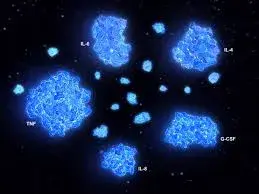The Cytokine Response to Mobilization in Critically Ill Patients
- younginnovatorsste
- Jun 27, 2024
- 4 min read

By: Michelle Li
Introduction
Approximately 20–50% of critically ill patients experience intensive care unit-acquired weakness (ICU-AW). ICU-AW includes a wide variety of disorders caused by polyneuropathy and myopathy after ICU admission and is associated with reductions in health-related quality of life and increased risks of death after hospital discharge. ICU-AW is potentially aggravated by long periods of bed rest due to routinely managed sedation and immobility. Currently, mobilization interventions delivered in the ICU setting are accepted as a therapeutic intervention that potentially prevents or attenuates functional impairment and ICU-AW [1]. Cytokines are small proteins that are crucial in controlling the growth and activity of other immune system cells and blood cells. When released, they signal the immune system to do its job. Cytokines affect the growth of all blood cells and other cells that help the body's immune and inflammation responses [2].
The Importance of Early Mobilization
Early mobilization has been proposed as a promising intervention to counteract ICU-AW because it attenuates critical illness-associated muscle weakness. A study reported that early exercise has the potential to decrease the length of the hospital stay and improve function in patients with acute respiratory failure (Berry, 2013). Another study proposed that early mobilization appears to be important for preventing postoperative complications, improving functional capacity, and reducing the length of hospital stay of patients who underwent cardiac surgery (Ramos Dos, 2017). In the same year, a study by Nydahl reported that early mobilization and physical rehabilitation for critically ill patients appear to be safe and have a low risk of potential adverse events. According to the 2018 study, early mobilization in the ICU exerts a positive and safe effect on hospital outcomes for patients who require mechanical ventilation (MV) because it confers the significant benefit of decreasing the duration of MV and the length of stay in the ICU (Zhang, 2018). In addition, the most recent Pain, Agitation/Sedation, Delirium, Immobility, and Sleep Disruption (PADIS) guideline suggests that rehabilitation or mobilization can be safely initiated in critically ill adults when the cardiovascular, respiratory, and neurological statuses are stable [1].
Cytokine Response to Critically Ill
Pro-inflammatory cytokines trigger or heighten inflammation. They relay messages that coordinate your body's immune response to fend off attackers, like germs. Anti-inflammatory cytokines stop or lessen inflammation. They relay messages that prevent an excessive immune response that can lead to tissue damage [3].
How Physical Activity and Mobilization Can Influence Cytokine Production
Physical activity and mobilization have significant impacts on cytokine production, especially in the context of critically ill patients. Cytokines are small proteins that play crucial roles in cell signaling, and they are key mediators of inflammation and immune responses. During physical activity, the body undergoes various physiological changes that can trigger the release of both pro-inflammatory and anti-inflammatory cytokines [4].
Changes in Cytokine Levels Post-Mobilization in Critically Ill Patients
Studies have shown that the response of cytokine production to physical activity can vary significantly based on the type, intensity, and duration the exercise. For critically ill patients, mobilization can lead to distinct patterns of cytokine responses, which may influence recovery and outcomes [4].
Short-Term Physical Activity on Pro-Inflammatory Cytokines
Short-term physical activities, including near-maximal short-duration exercise, anaerobic exercise, and concentric and eccentric activities, have been studied to understand their impact on cytokine production. The response to physical activity differs appreciably with the mode of exercise, availability of carbohydrates, and core temperature . For example, a study found that IL-6 mRNA is present in exercising muscle but not in the blood, indicating localized cytokine production (Bruunsgaard, 2012). Additionally, no changes were observed in mRNA levels for IL-1β, IL-6, and TNFα in circulating cells in response to three hours of moderate endurance exercise (Moldoveanu, 2012). Flow cytometry studies have demonstrated that an increased percentage of circulating monocytes express pro-inflammatory cytokines intracellularly during and immediately following vigorous exercise, suggesting these cells as a source of cytokines [4].
Physical Activity on Anti-Inflammatory Cytokines
Exercise has been shown to induce significant increases in anti-inflammatory cytokines, particularly IL-1 receptor antagonist (IL-1ra). The levels of IL-1ra can increase from 2- to 214-fold depending on the intensity and duration of the exercise. For instance, elite runners showed a 5-fold increase in plasma IL-1ra immediately after a six-hour endurance race, while another study reported a 78-fold increase following 2.5 hours of exercise at 75% V̇O2max (Ostrowski, 2014). The largest increase, 214-fold, was observed immediately after a marathon race [4].
Future Prospects
Balancing mobilization with the critical illness state is essential to managing cytokine responses effectively. Mobilization can induce beneficial changes in cytokine production, reducing inflammation and potentially improving patient outcomes. However, the intensity, duration, and timing of mobilization must be carefully considered to avoid adverse effects and optimize the therapeutic benefits.
Continued research is crucial to refine mobilization practices for critically ill patients. Future studies should focus on identifying the optimal protocols that balance the benefits of mobilization with the patients' critical conditions. By advancing our understanding of how different mobilization strategies influence cytokine responses, we can develop personalized interventions that enhance recovery, reduce ICU-acquired weaknesses, and improve overall patient outcomes.
------------------------------------------------------------------------------------------------------------------------
Michelle Li is a rising 12th grader from the Midwestern United States, specializing in biological sciences.
Works Cited
“Early mobilization of critically ill patients in the intensive care unit: A systematic review and meta-analysis” https://www.ncbi.nlm.nih.gov/pmc/articles/PMC6776357/#sec005title
“Cytokines and Their Side Effects” https://www.cancer.org/cancer/managing-cancer/treatment-types/immunotherapy/cytokines.html#:~:text=Cytokines%20are%20small%20proteins%20that,body's%20immune%20and%20inflammation%20responses.
“Cytokines” https://my.clevelandclinic.org/health/body/24585-cytokines
“The Cytokine Response to Physical Activity and Training” https://www.ncbi.nlm.nih.gov/pmc/articles/PMC7101891/



Comments